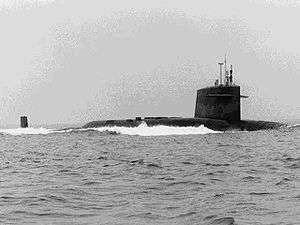Ethan Allen-class submarine
The Ethan Allen class of fleet ballistic missile submarine was an evolutionary development from the George Washington class. The Ethan Allen, together with the George Washington, Lafayette, James Madison, and Benjamin Franklin classes comprised the "41 for Freedom" that were the Navy's main contribution to the nuclear deterrent force through the late 1980s.
 USS Ethan Allen | |
| Class overview | |
|---|---|
| Name: | Ethan Allen class |
| Builders: | |
| Operators: |
|
| Preceded by: | George Washington class |
| Succeeded by: | Lafayette class |
| Built: | 1959–1963 |
| In commission: | 1961–1992 [1] |
| Completed: | 5 [1] |
| Retired: | 5 [1] |
| General characteristics | |
| Type: | Ballistic Missile Submarine |
| Displacement: |
Surfaced: 6,946 long tons (7,057 t) Submerged: 7,884 long tons (8,011 t)[2] |
| Length: | 410 feet 4 inches (125.1 m) |
| Beam: | 33.1 feet (10.1 m) |
| Draft: | 29 feet 10 inches (9.1 m) |
| Propulsion: |
|
| Speed: |
|
| Test depth: | 1,300 feet (400 m)[2] |
| Complement: | 12 Officers and 128 Enlisted (two crews, "Blue" and "Gold") |
| Armament: | 16 Polaris A2/A3 missiles, 4 × 21 inch (533 mm) torpedo tubes, 12 torpedoes[2] |
Design
Rather than being designed as Skipjack-class attack submarines with a missile compartment added, the Ethan Allens were the first submarines designed "from the keel up" as Fleet Ballistic Missile (FBM) submarines carrying the Polaris A-2 missile. They were functionally similar to the George Washingtons, but longer and more streamlined and with torpedo tubes reduced to four. In the early and mid-1970s, they were upgraded to Polaris A3s. Because their missile tubes could not be modified to carry the larger diameter Poseidon missile,[4] they were not further upgraded.
Conversions
To comply with SALT II treaty limitations as the Ohio-class ballistic missile submarines entered service, in the early 1980s the Ethan Allens were refitted and officially designated SSNs (fast attack submarines), but often referred to as a "slow approach". Their missile fire control systems were removed and the missile tubes were filled with concrete. Sam Houston and John Marshall were further converted to carry SEALs or other Special Operations Forces, accommodating 67 troops each with dry deck shelters to accommodate SEAL Delivery Vehicles or other equipment. The Ethan Allen-class submarines were decommissioned between 1983 and 1992.[5] All were disposed of through the nuclear Ship-Submarine Recycling Program 1992-1999.
Boats in class
Submarines of the Ethan Allen class:[1][5][6]
| Name and hull number | Builder | Laid Down | Launched | Commissioned | Fate |
|---|---|---|---|---|---|
| Ethan Allen (SSBN-608) | General Dynamics Electric Boat | 14 September 1959 | 22 November 1960 | 8 August 1961 | Decommissioned 31 March 1983. Disposed of through Ship-Submarine Recycling Program, 1999 |
| Sam Houston (SSBN-609) | Newport News Shipbuilding and Drydock Co. | 28 December 1959 | 2 February 1961 | 6 March 1962 | Decommissioned 6 September 1991. Disposed of through Ship-Submarine Recycling Program, 1992 |
| Thomas A. Edison (SSBN-610) | General Dynamics Electric Boat | 15 March 1960 | 15 June 1961 | 10 March 1962 | Decommissioned 1 December 1983. Disposed of through Ship-Submarine Recycling Program, 1997 |
| John Marshall (SSBN-611) | Newport News Shipbuilding and Drydock Co. | 4 April 1960 | 15 July 1961 | 21 May 1962 | Decommissioned 22 July 1992. Disposed of through Ship-Submarine Recycling Program, 1993 |
| Thomas Jefferson (SSBN-618) | Newport News Shipbuilding and Drydock Co. | 3 February 1961 | 24 February 1962 | 4 January 1963 | Decommissioned 24 January 1985. Disposed of through Ship-Submarine Recycling Program, 1998 |
See also
| Wikimedia Commons has media related to Ethan Allen class submarines. |
- "41 for Freedom" Fleet Ballistic Missile submarines
- Fleet Ballistic Missile
- List of submarines of the United States Navy
- List of submarine classes of the United States Navy
References
- "SSBN-608 Ethan Allen-Class FBM Submarines" from the FAS
- Friedman, Norman (1994). U.S. Submarines Since 1945: An Illustrated Design History. Annapolis, Maryland: United States Naval Institute. pp. 199–200, 244. ISBN 1-55750-260-9.
- Polmar, Norman (1981), The Ships and Aircraft of the U.S. Fleet (12th ed.), London: Arms and Armour Press, p. 22, ISBN 0-85368-397-2
- Gardiner, Robert; Chumbley, Stephen, eds. (1995), Conway's All the World's Fighting Ships 1947–1995, Annapolis, USA: Naval Institute Press, p. 612, ISBN 1-55750-132-7
- California Center of Military History (dead link 2015-05-07) Archived 27 September 2013 at the Wayback Machine
- This article incorporates text from the public domain Dictionary of American Naval Fighting Ships.